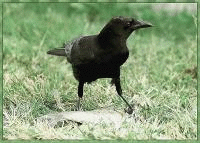West Nile Virus Risk Analysis for the City of Burnaby
Outline
According to Health Canada, CBC Indepth, USGS, and World Health Organization, most people infected with West Nile virus got it from the bite of an infected mosquito. A mosquito becomes infected when it feeds on the blood of a bird that is infected with the virus. About two weeks later, the mosquito becomes capable of passing the virus to people and animals (e.g. birds and horses) by biting them. Therefore the focus for this analysis is to locate mosquitoes’ breeding grounds and birds’ habitats to the relevant risks to different parts of Burnaby.
Several types of birds such as American Crow and Raven are the major carrier of West Nile virus. Since American Crow is the dominator as West Nile Virus carrier, the factors will be measured and be focused on American Crow’s habitats.
 |
|||||
 |
|||||
|
American Crow (Picture source: American Crows) |
|||||
| American Crow's Distribution in North America
(Picture source: U. S. Geological Survey) |
|||||
According to Corvus brachyrhynchos, Breeding Bird Atlas, National Audubon Society Field Guide to North American Mammals, Northwest Trek and Canadian Cooperative Wildlife Health Centre - Bird Identification Page, suitable habitats for American Crow including woodland, undeveloped and open area, parks and farmland area. They are also highly adaptive to changing environment, they locate almost everywhere in North America from Atlantic Ocean to Pacific Ocean. American Crows are also able to survive in cities where human establishments are; they can also find food from human societies. Moreover, wetland, around lakes and standing waters besides parks, undeveloped and open area, and wood area are also favourable habitats for mosquitoes to breed. There for I have selected six factors to analysis risk of West Nile Virus in Burnaby.
Six factors are used for the analysis. The six factors are wood area factor, wetland factor, parks factor, streets factor, water body factor and undeveloped and open area factor. These six factors developed based on ideas acquired from the references in the References page to seek out mosquitoes’ breeding grounds and habitats:
Undeveloped and Open Area Factor: Undeveloped Area usually are good breeding ground for mosquitoes where plants, insects and so on can grow wild. These are areas that are suitable for American Crows to live as well.
Wetland Factor: Wetland is the most favourable breeding ground for mosquitoes where areas of stagnant water can be spotted easily.
Water body Factor: Mosquitoes tend to breed nearby lakes where standing water can be found.
Wood Area Factor: Mosquitoes can bite birds in these areas to transfer West Nile virus. American Crows also prefer to live in woodland.
Parks Factor: Same as the wood area factor, it is easy for mosquitoes to bite birds and human to transfer West Nile virus. Also, this is a nice habitat for American Crow.
Streets Factor: On the major roads as they are paved by cement, are not good breeding grounds for mosquitoes and will certainly scary the birds away.
The Constraint is the size of City of Burnaby.
Please move on to Data section and Methodology section to see what data and how the data were used.
_______________________________________________________________________________________________________________
Site best viewed with resolutions of 1024x768. QuickTime Player is required to browse image results.
This site is created by Jimmy Man Ching YIP for GEOG 355 2003-3.